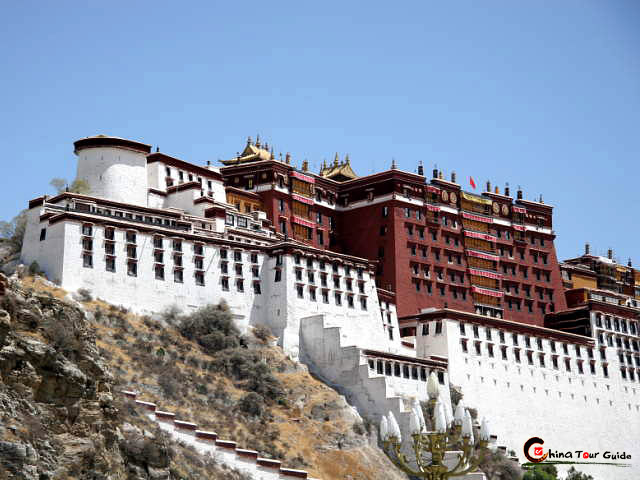Tibet is an extraordinary travel location, so much history and mystery. Barkhor Street is Lhasa’s pilgrimage circuit around Jokhang Temple. The street is also a busy shopping street, selling a mind-boggling array of souvenirs from Tibet and Nepal. Join the pilgrims as they circle clockwise around Jokhang Temple to roll the prayer wheels, or join the locals or travelers haggling hard over souvenirs. Most travelers stroll around this street after a visit to Jokhang Temple. Allow plenty of time to explore the local shops. All shops on the street close early in the evenings.
Yamdrok Lake is one of the four “Great Wrathful Lakes” guarded by the goddess Dorje Gegkyi Tso and is regarded as one of the most sacred of the holy lakes in Tibet. It is so sacred that Tibet’s fate is traditionally tied to this freshwater lake: it is believed that if Yamdrok Tso Lake dries, Tibet would not be habitable. Yamdrok Lake is a72 km (45 mi) long fresh water lake and has a very beautiful scenery. Its crystal clear, blue waters are surrounded by snow-capped mountains.The lake is also one of the most easily accessible of the holy lakes. It is on Friendship Highway S307 (the highway connecting Nepal to Tibet), and you can have a panoramic view of the lake from the road. In addition to Chinese visa to enter the country, you need an additional visa called Tibet Visa, or Tibet permit to enter the Tibet Autonomous Region. This document is issued by Tibet Tourism Bureau (TTB) and arranged by the tour operator (it usually takes 3 workdays to get this permit). This document is needed before buying the travel ticket to Tibet. Tibet Travel Permit alone will only allow you to enter Lhasa City and some parts of Shigatse Prefecture and Lhoka and Nyingchi, Nagqu, etc. For getting out of Lhasa City, you need one more document named Aliens’ Travel Permit. The Alien’s Travel Permit is issued by police, Public Security Bureau. If you are planning to go out of Lhasa City and visit places in “unopened areas” like Shigatse, Samye Monastery or Everest Base Camp, you need this document.
Tibet trekking top locations : Advanced Everest Base Camp Trek: This is one of the most spectacular treks in Tibet and also the world’s highest elevation trek ending at 6340m (20800 feet). The trek itself does not take more than a week but you need to tack on another 3 days on each side for the overland journey from either Lhasa or Kathmandu. The trek starts when you reach the small monastery of Rongbuk from where you can look up the valley of the same name directly at Mount Everest. Its only 22km (12 miles) to the Advanced Base camp but you are gaining (4300 ft / 1310m) which is more than it seems given the already high elevation. The trek is usually divided into several days with an intermediate base camp set up so that you can go up and down the mountain at your own speed while you acclimatize. This is the same route used by climbers using the North Col to summit Everest.
The Ruins of Guge Kingdom is in today Zhada County, Ngari Prefecture. Guge is said to be the highest ancient kingdom located on the ridge of Tibet. More than 1,000 years ago, a powerful kingdom with a splendid civilization was born in Ngari. It is the highest ancient kingdom located on the ridge of Tibet. Now the ruins cover an area of 200,000 square meters. The buildings follow the hill to the top in a rigid layout and an imposing manner. The 11-storey castle is more than 300-meter high including houses, caves, pagodas, blockhouses, defense works and tunnels. There are a total number of 1,416 surviving pieces of architecture, including 879 caves, 445 houses, 60 blockhouses, 28 pagodas, and four tunnels, which lead in all directions inside the architectural group of the Ruins of Guge Kingdom. At the outer ring there are walls made of loess, which are decorated with many figures of Buddha, scriptures and incantations in Tibetan, and Sanskrit engraved on large cobbles. The houses within the ruins have wooden structures and level roofs. The larger works of architecture include the Red Temple, the White Temple, the king palace and the meeting hall. The White Temple and the Red Temple are about the same size, covering 300 square meters. Within the temple there are 36 square pillars. The pillars and the ceiling are covered with colored drawings of patterns and figures of Buddha, and all the walls are covered with frescoes of different subjects. The only path from the base of the hill to the palace halls on the hilltop is a man-made tunnel. The upper part of the Guge Castle holds the Winter Hall and Summer Hall, where the royal family lived. They are empty now. Only the frescos and wooden engravings in Tancheng Hall are well preserved. Guge colored paintings, frescos and sculptures are rich works of a high artistic level and immense research value.
As Tibetans, our core values are our rich culture, indigenous tradition and natural environment. We are proud to be one of the first companies in the region to practice Responsible Tourism. In a nutshell, it is tourism “that creates better places for people to live in and better places for people to visit.” We design our tours to pass through smaller Tibetan villages to utilize their services. By partnering with Tibetan owned hotels, family-run guesthouses, restaurants and handicraft shops we can promote local economic growth. Read extra info at Tibet travel permit.
